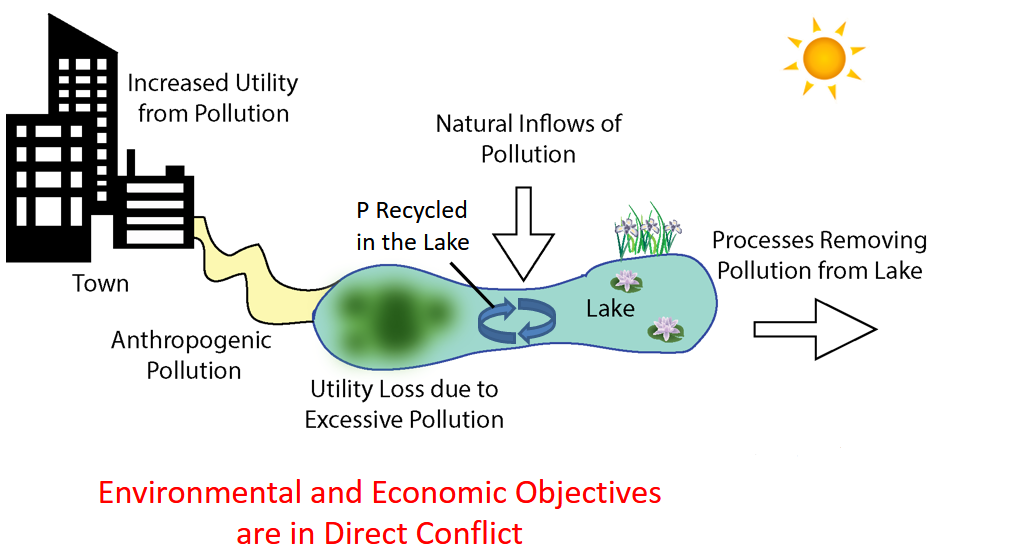The Shallow Lake Problem#
Introduction#
Managing socio-ecological systems is a challenge wrought by competing societal objectives, deep uncertainties, and potentially irreversible tipping points. A classic example is the shallow lake problem in which a hypothetical town situated on a lake must develop pollution control strategies to maximize its economic benefits while minimizing the probability of the lake crossing a critical phosphorus (P) threshold, above which it irreversibly transitions into a eutrophic (polluted) state. Here, you’ll explore two optimization strategies to design robust pollution control rules for the town that account for deeply uncertain system characteristics and conflicting objectives.

Learning objectives#
Visualize dynamics of a socio-ecological system and identify tipping points
Get familiar with Python code to simulate the shallow lake problem
Implement a multiobjective evolutionary algorithm (MOEA) to discover non-dominated decision alternatives
Visualize tradeoffs between conflicting objectives
Evaluate MOEA performance by implementing common performance measures for evolutionary algorithms
Examine the impact of uncertainties using global sensitivity analysis
Discover thresholds in the uncertainty space that lead to policy alternatives crossing the irreversible tipping point
Prerequisites#
A working knowledge of Python
Training activities#
Topic |
Commitment |
Tasks |
Readings |
Outcomes |
|---|---|---|---|---|
Introduction to the Shallow Lake Problem Model |
M |
Review the basic Shallow Lake Problem Function |
[1] |
Gain an understanding of the Shallow Lake Problem |
Examining tipping points |
M |
Recreate Figure 1 in [2] (non-linear dynamics of the lake) |
[2] (sections 1 and 2) |
Explore equilibrium concepts and tipping points |
Introduction to Rhodium |
S |
Install Rhodium |
[3], Rhodium Github |
Install and get started using Rhodium |
Intertemporal optimization and open-loop control |
M |
Implement an intertemporal optimization formulation and examine tradeoffs |
[4] |
Use optimization to come up with a simple strategy to manage the lake |
Direct Policy Search |
M |
Implement the Direct Policy Search formulation for phosphorus |
[2] sections 3-6 |
Compare Direct Policy Search with intertemporal optimization |
Sensitivity analysis and scenario discovery |
M |
Use Rhodium to perform sensitivity analysis and scneario discovery |
Explore how uncertainties impact the performance of lake policies |
Commitment: S = Short ( < 1 day), M = Medium (1-5 days), L = Long (>5 days)
Reading list#
[1] Carpenter, Stephen R., Donald Ludwig, and William A. Brock. “Management of eutrophication for lakes subject to potentially irreversible change.” Ecological applications 9.3 (1999): 751-771.
[2] Quinn, J. D., Reed, P. M., & Keller, K. (2017). Direct policy search for robust multi-objective management of deeply uncertain socio-ecological tipping points. Environmental Modelling & Software, 92, 125-141.
[3] Hadjimichael, A., Gold, D., Hadka, D., & Reed, P. (2020). Rhodium: Python library for many-objective robust decision making and exploratory modeling. Journal of Open Research Software, 8.
[4] Ward, V. L., Singh, R., Reed, P. M., & Keller, K. (2015). Confronting tipping points: Can multi-objective evolutionary algorithms discover pollution control tradeoffs given environmental thresholds?. Environmental Modelling & Software, 73, 27-43.
[5] Herman, J. D., Reed, P. M., Zeff, H. B., & Characklis, G. W. (2015). How should robustness be defined for water systems planning under change?. Journal of Water Resources Planning and Management, 141(10), 04015012.
Necessary Software#
https://github.com/Project-Platypus/Rhodium
